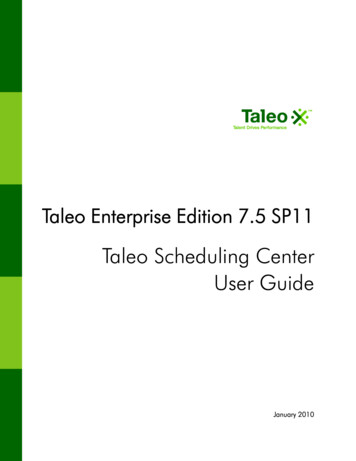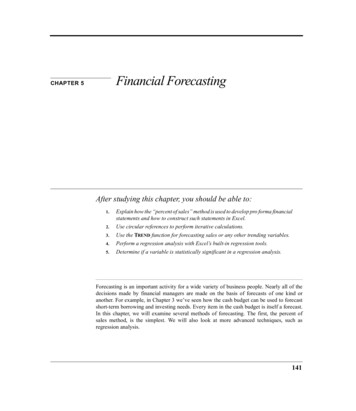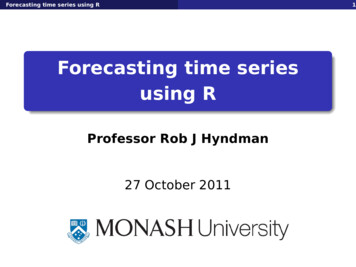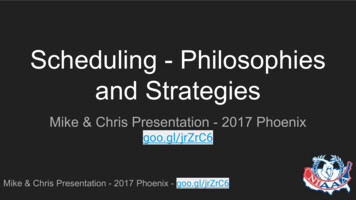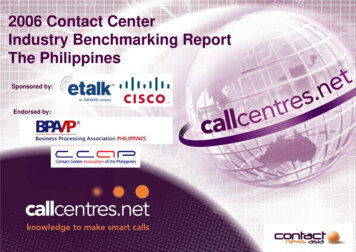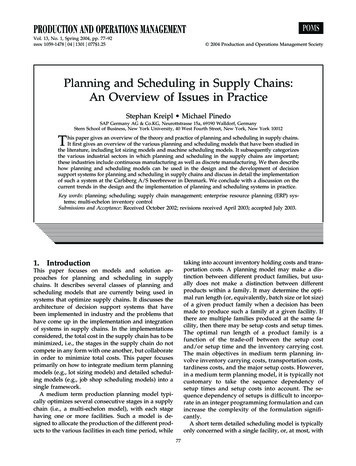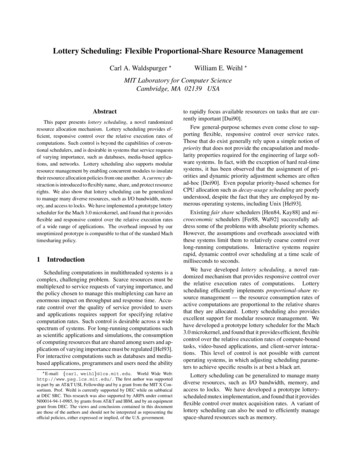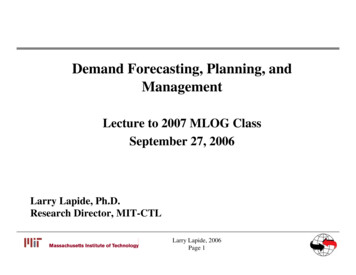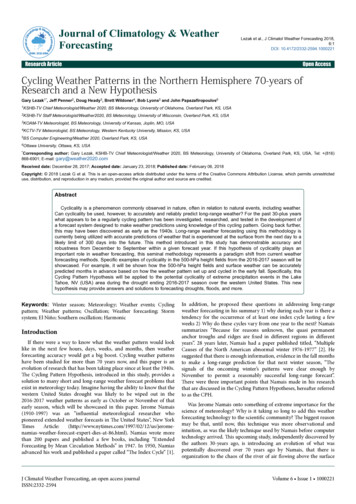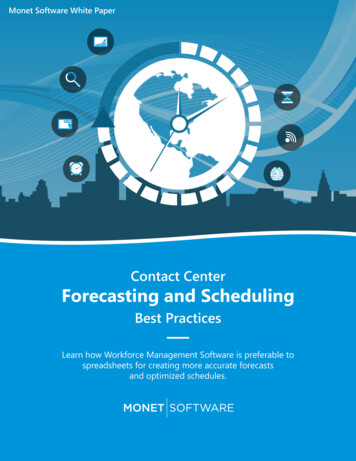
Transcription
Monet Software White PaperContact CenterForecasting and SchedulingBest PracticesLearn how Workforce Management Software is preferable tospreadsheets for creating more accurate forecastsand optimized schedules.1
Contact Center Forecasting and Scheduling:Best PracticesForecasting and scheduling are vital components in the success of every contact center. Each plays significantroles in budgeting, customer service and agent satisfaction, so there is no room for miscalculation.Correct forecasting and (to a lesser extent) scheduling is both an art and a science. The scientific componentutilizes specific calculations of specific numbers, to create agent rosters for a shift or time period. But numbersalone cannot quantify the skills of individual agents, varying start times, end times and break times, or the everpresent need to change personnel based on unique circumstances. Thus, creativity is required from the contactcenter manager as much as cold calculation.The Traditional Method: SpreadsheetsAt least 20% of contact centers still use spreadsheets for forecasting and scheduling. However, with thismethod precision calculation is more difficult, if not impossible.A spreadsheet can be used to calculate workforce percentages, but precise forecasting requires more in-depthanalysis.Example: A manager reviews a forecast and finds an overall weekly variance of 4%. This figure is reached aftera week in which the Monday forecast was 12% under call volume, Tuesday was 8% under, and Wednesdaythrough Friday were all 8% over projections.While 4% seems encouraging, it does not account for how customer service may have suffered on Mondayand Tuesday by an insufficiently staffed contact center. In this case, instances of overstaffing and understaffing2
canceled each other out, resulting in a favorableforecasting picture at an inefficient business.This manager may feel good about a 4% variance,but he or she is overseeing a center that is routinelyis missing service levels, likely resulting in dissatisfiedcustomers.Consider also the impact that inaccurate forecastinghas on agents, who may either be sitting idly in acubicle or stressed to keep up with unanticipated callvolume.Forecasting can be rendered more accurate throughthe use of a simple standard deviation approach, andby examining intra-day forecast accuracy as well asjust how close the daily or weekly numbers comparedto the forecast. With spreadsheets, the managerfaces a much more daunting challenge in tracking,monitoring and improving schedule adherence.Typically, a manager may start with monthly andweekly stats, and then delve deeper into daily andhourly numbers, perhaps even examining workperiods as short as 15 minutes. With WFM, it ismuch easier to analyze call types, call volume andcall patterns. Note past variations, determine theircause, and forecast accordingly for that same timeperiod.A Better Way: WorkforceManagementNext, forecast special days or other events thatimpact call volume. In some cases, such as anannual holiday, the variance is likely to repeat;in others, such as a temporary power outage,the same variance is highly unlikely. Additional“special day” provisions should also be made forother factors, including any company marketingcampaigns or events, and perhaps even weatherpatterns.An automated workforce management (WFM)solution can improve forecast accuracy, making sureall the necessary resources are always in place. It canalso streamline the scheduling process.ForecastingAll of these calculations may be done manuallywith a spreadsheet, but it’s much faster and moreaccurate to work with real-time and historic calldata collected by a WFM system. WFM also allowsfor more detailed and specific forecast simulations.Conceptually, creating a forecast is creating amodel, and historical data is necessary for anaccurate model. Past activity is always the bestpredictor of future activity, especially when brokendown into ever-smaller increments of time. Thismakes it easier to identify anomalies and prepareaccordingly.Once all of this data has been reviewed, you’llbe ready to prepare a forecast, assess staffrequirements and create a schedule.The selection of which historical data is mostimportant is the key to creating a reliableforecast. This will vary depending on businesstype. A company with a monthly sales cycle willbe different than a seasonal business. For someforecasts data from the previous year will becritical; in some cases, call volumes from last weekwill be more important.SchedulingThe objective for a contact center manager is tocreate a schedule that balances agent needs vs.contact center capabilities, and that accounts forshrinkage and exceptions.3
Spreadsheets are adequate for fixed schedules –but contact center schedules rarely stay fixed.Tracking adherence following a shift or a day isa missed opportunity to correct any issues morequickly. Such tracking is practically impossible withjust a spreadsheet. Spot-checks can be beneficial,but without the real-time tracking provided byWFM there is a much higher risk of over/understaffing, shrinkage and missed service levels. WFMalso provides insight, through dashboards andreal-time alerts, into which agents are meetingtheir schedule obligations, and which may requireadditional guidance or training.A WFM system provides the flexibility toautomatically manage start times, end times andbreak times. Spreadsheets cannot match thisspeed and efficiency, which results in unhappyagents and higher shrinkage.When agents can work the hours that work bestfor them, service levels improve. While everyrequest may not be accommodated, especiallywhen some agents work part time and otherswork from home, every time a day off requestcan be granted or an exception approved withoutimpacting service level, it encourages positive jobperformance that reflects satisfaction with thecompany. Employee turnover will be reduced aswell.However, part of best practices in schedulingalso depends on hiring agents that are opento schedule flexibility. This is necessary to meetcustomer service targets with fewer personnel,and to avoid overstaffing.Such flexibility can be encouraged throughincentive programs, with more amenable agentsreceiving preferred shifts or higher compensation.Contact centers should also have a clear tiersystem in place ranking agents by skills basedon call type. The ultimate goal is to have onlyagents that are capable of handling every typeof customer call. Thus, performance remainsconsistent no matter how schedules may fluctuate.Once a manager has calculated and plannedresources requirements (by reviewing forecastingdata and defining acceptable service levels onASA, AHT and other factors), intra-day adherencetracking is another significant component of abest practices approach.4
WFM and Agent ProductivityWorkforce Management (WFM) can play a prominent role in engendering employee satisfaction, particularly inthe areas of schedule flexibility and online collaboration between agents and supervisors. In addition to moreefficient skill-based scheduling, which improves both employee confidence and customer service, the reportingand transparency tools offer more accurate assessments of agent performance.Choosing a WFM SolutionDifferent contact centers have different priorities, and these should be reviewed so any WFM solutionwill increase efficiency and service levels, while also reducing costs. Here are some of the more significantevaluation criteria for any WFM software solution.CapabilitiesCapabilities should include accurate call volume forecasting from historical data and ACD integration,flexible schedule creation that incorporates foreseen and unforeseen variables, agent exceptions, intraday changes to both forecasting and scheduling, and performance management reports.ImplementationCalculate how long the software will take to implement, and how quickly it should begin payingdividends.IntegrationHow well will the system work with the contact center’s existing hardware, for such necessities assharing of vital data? Will custom integration be required?CostIncorporate upfront costs, ongoing monthly or maintenance costs, and any hidden costs. Can thesystem be used over the web without equipment purchase?UsabilityHow long will it take for agents to get comfortable with the system? Is it confusing? Are there too manyfeatures that you may not need, but that can complicate usage?UnificationHow unified will the user experience be across solution components? Will the dashboards showeverything necessary to monitor a call and discover how and where corrections should be made?MetricsBesides forecasting, scheduling and adherence, other key WFM metrics that should be able to bereviewed via dashboard include call answer times, first call resolutions and transfer rates.ScalabilityCan the solution grow with the contact center? Can modules be added without additional hardwarecosts?ROIWhat will the return on investment (ROI) be, and how quickly will any software investment be recouped?5
ConclusionAccurate forecasts are vital to contact center customer service and budgeting, and avoidingadditional issues that occur when the center is overstaffed or understaffed. Forecastingmethods must take into account changing business needs, seasonal volumes and externalevents that are outside the company’s control.Those still using spreadsheets for these functions are missing out on the convenience,efficiency, flexibility and functionality of workforce management. The calculations necessaryfor optimal forecasts and schedules are very difficult to do with Excel. WFM has sophisticatedsimulation processes that tell a contact center how many people they will need and when theywill need them.Is there an optimal use for spreadsheets? Perhaps – where the call flows are the same everyhour of every day. Unfortunately, such a contact center does not exist. When call volumechanges, spreadsheets are insufficient.With WFM, managers can get back to managing people, instead of spending hours on Excelplanning forecasts and schedules.About Monet WFMMonet Software is a global provider of workforce optimization software solutions forcontact centers and helpdesks. Monet’s cloud-based solution is an affordable and easy touse workforce optimization software solution, which includes workforce management, callrecording, quality assurance, and performance management.Contact centers and helpdesks will start improving service levels and reducing center costswithout the upfront expenses and IT requirements of traditional workforce software.For more information about Monet Software, please call 310-207-6800 or go towww.monetsoftware.comShare this Whitepaper Copyright 2018, Monet Software. All rights reserved6
Contact Center Forecasting and Scheduling: Best Practices Forecasting and scheduling are vital components in the success of every contact center. Each plays significant roles in budgeting, customer service and ag
